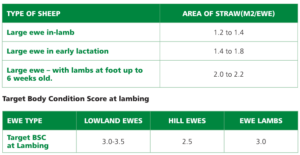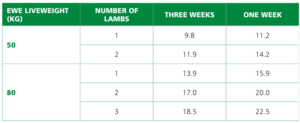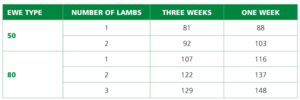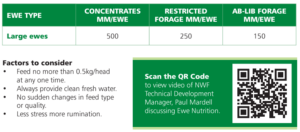Demand on the ewe is significantly increased during late pregnancy. This is when up to 75% of foetal growth occurs and the requirement for energy and protein is significantly increased. Under or over nutrition at this point in the pregnancy, can have a detrimental effect on the lambing success, and survival rate of lamb and puts pressure on profitability and margin.
Action Points
- Take a forage sample and get it analysed.
- Choose an appropriate feed supplement based on forage analysis and farming system.
- Formulate rations, planning diet changes/amounts fed.
- Ensure all housing, penning and equipment is ready.
- Group ewes according to scanning results, lamb numbers and body condition score.
- Monitor intakes of forage and change accordingly.
- Plan a turnout routine and grazing.
Groups
Ideally, ewes should be grouped and fed according to the number of lambs being carried, body condition score and parturition number. This should take place 6 weeks pre-lambing or at housing. Thin singles can be grouped with twins. Thin twin bearing ewes can be grouped with triplet bearing ewes, this extra feeding of thinner ewes will meet the extra nutrient demand and ensure a higher plane of nutrition.
Housing Requirements
To ensure ewes have sufficient lying areas and are able to display natural signs of behaviour please see below standards for lying areas.
Lambing ewes in the correct body condition score can have great influence on:
- • Lamb birth weights, vigour and survival rate.
- Ewes mothering ability.
- Udder development.
- Colostrum and milk quality and quantity.
- Losses due to metabolic disease, prolapse or dystocia.
Ewe Requirements
The ewes’ demand for energy and protein increases with liveweight and number of lambs carried. As lambing approaches, there is a 15% increase in ME and MP requirement from week 3 to 1 week before lambing.


Practical feeding
Forage should be available at all times when ewes are housed for lambing to maintain a stable rumen environment. Forage should be offered daily and regularly pushed up or turned to encourage ewes to get up and come to feed which will increase dry matter intake. Ewes should be fed at the same time every day as ewes anticipate feeding times and adjust their forage intake. Erratic feed times, particularly when feeding concentrate, can lead to unfavourable changes in rumen microflora and function, by interfering with saliva production.
Whatever your feeding system you must ensure that ewes have sufficient space and a chance to get their fair share of concentrate feed. Greedy ewes can eat too much while shy feeders may get too little. Both situations can lead to more prolapse and pregnancy toxaemia as well as variation in body condition score. All feed offered to ewes should be of the highest quality, fresh, free from mould, yeasts and contamination. Trough feeders should be moved and cleaned regularly to avoid build-up of stable unpalatably feed. To ensure maximum dry matter intakes are achieved we must ensure there is adequate feed trough space.
For further information on NWF Sheep Feeds, please click HERE.
